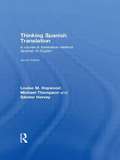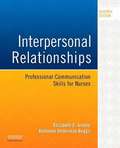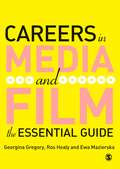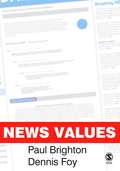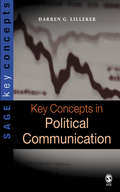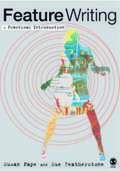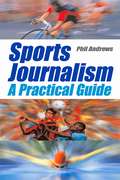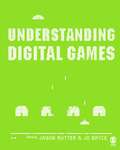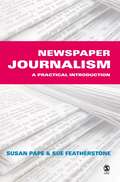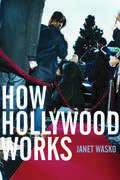- Table View
- List View
Thinking Spanish Translation: Spanish to English
by Louise Haywood Sándor Hervey Michael ThompsonThe new edition of this comprehensive course in Spanish-English translation offers advanced students of Spanish a challenging yet practical approach to the acquisition of translation skills, with clear explanations of the theoretical issues involved. A variety of translation issues are addressed, including: cultural differences register and dialect grammatical differences genre. With a sharper focus, clearer definitions and an increased emphasis on up-to-date 'real world' translation tasks, this second edition features a wealth of relevant illustrative material taken from a wide range of sources, both Latin American and Spanish, including: technical, scientific and legal texts journalistic and informative texts literary and dramatic texts. Each chapter includes suggestions for classroom discussion and a set of practical exercises designed to explore issues and consolidate skills. Model translations, notes and suggestions for teaching and assessment are provided in a Teachers' Handbook; this is available for free download at http://www. routledge. com/cw/thinkingtranslation/ Thinking Spanish Translationis essential reading for advanced undergraduate and postgraduate students of Spanish and translation studies. The book will also appeal to a wide range of language students and tutors through the general discussion of the principles and purposes of translation. 9781134070183 9780415481304 9780203886014 9780415440042
Introducing Translation Studies: Theories and Applications (PDF)
by Jeremy MundayThis introductory textbook provides an accessible overview of the key contributions to translation theory. Munday explores each theory chapter-by-chapter and tests the different approaches by applying them to texts. The texts discussed are taken from a broad range of languages - English, French, German, Spanish, Italian, Punjabi, Portuguese and Spanish - and English translations are provided. A wide variety of text types is analysed, including a tourist brochure, a children's cookery book, a Harry Potter novel, the Bible, literary reviews and translators' prefaces, film translation, a technical text and a European Parliament speech. Each chapter includes the following features: * a table introducing key concepts * an introduction outlining the translation theory or theories * illustrative texts with translations * a chapter summary * discussion points and exercises. Including a general introduction, an extensive bibliography, and websites for further information, this is a practical, user-friendly textbook that gives a balanced and comprehensive insight into translation studies. 9780415396943 9780415396936 9780203869734 9780415229265
Becoming a Translator: An Introduction to the Theory and Practice of Translation
by Douglas RobinsonFusing translation theory with advice and information about the practicalities of translating, Becoming a Translator is an essential resource for novice and practising translators. The book helps students learn how to translate faster and more accurately, how to deal with potential problems, including dealing with stress and how the market works. This second edition has been revised throughout, and includes an exploration of new technologies used by translators and a 'Useful Contacts' section including the names, addresses and web addresses of translator organizations, training programmes, journals and translator agencies. Exercises, email exchanges and examples have also been updated throughout. Becoming a Translator is an invaluable guide for all aspiring and practising translators. 9780415300322 9780203425961
Becoming a Translator: An Introduction to the Theory and Practice of Translation (PDF)
by Douglas RobinsonFusing translation theory with advice and information about the practicalities of translating, Becoming a Translator is an essential resource for novice and practising translators. The book helps students learn how to translate faster and more accurately, how to deal with potential problems, including dealing with stress and how the market works. This second edition has been revised throughout, and includes an exploration of new technologies used by translators and a 'Useful Contacts' section including the names, addresses and web addresses of translator organizations, training programmes, journals and translator agencies. Exercises, email exchanges and examples have also been updated throughout. Becoming a Translator is an invaluable guide for all aspiring and practising translators. 9780415300322 9780203425961
Corporate Communication: A Guide to Theory and Practice (PDF)
by Professor Joep P. CornelissenWritten specifically for students interested in knowing more about the organizational and management context of communications, and to get more hands-on learning, practical experience and skills to help them get off to a flying start in their career, this book is a guide to corporate communication that will help students and practitioners navigate the area, understand the main theories and put these into practice through examples and case studies. Academically grounded, it covers the key concepts, principles and models within corporate communication by bringing together academic knowledge and insights from the subject areas of management and communication. At the same time, it combines this academic base with a clear practical outlook – practical cases illustrate the theory and each chapter also focuses on models and exercises that equip students with practical expertise and skills. The international scope of the book, featuring cases from around the globe has been instrumental in its success and has now been used by nearly 20,000 students across over 50 different countries from New York to Helsinki, Tokyo to Rio de Janeiro for students studying Corporate Communication, Organizational Communication, PR and Marketing Communications and as an invaluable source for reflective practitioners. The new fourth edition has been revised and updated with new cases and covers developments is areas such as reputation management, leadership communication and CSR communication. It features: A new chapter on social media and increased coverage of new media in existing chapters New up-to-date material on emerging CSR standards, transnational governance and corporate citizenship Extended focus on media relations, internal communications and leadership and change communication New full-length and shorter international case studies Enhanced companion website material including new case studies and video material available on publication at www.sagepub.co.uk/cornelissen4e
The Dynamics Of Persuasion: Communication And Attitudes In The 21st Century
by Richard M. PerloffWith substantial revisions reflecting new research and changes in society, the fifth edition of The Dynamics of Persuasionintroduces students to major theories of persuasion and attitudes, using theory as the key to unlock the mysteries of contemporary social influence. Organized in terms of major concepts, issues, and persuasion contexts, the book offers a lucid introduction to the body of scholarly knowledge on persuasion, up-to-date examples of persuasion in real life, and a thorough discussion of the ethics of persuasion in contemporary society. This package includes a free one-year subscription to an enhanced Interactive eTextbook, complete with author-narrated chapter synopses, videos, exercises, flashcards, and more resources for instructors and students. Key features of the interactive e-textbook: * Anytime, anywhere access via VitalSource's Bookshelf; the most used eTextbook platform in the world * End-of-chapter interactive exercises; multiple-choice exercises to encourage students to test their understanding of the key concepts * Audio chapter introductions from the author * Note taking and sharing functionalities * Clickable definitions for key terms * Hyperlinked further reading with links to key websites selected by the author * A full color version of the text. Available Instructor Resources: * An instructor manual * An image bank drawn from the text * A video playlist with complementary discussion questions * Chapter-by-chapter slides which instructors can adapt and integrate with their teaching * Web links to useful websites and further reading Visit RoutledgeInteractive. comwhere instructors can register to access the instructor resources for free.
The Dynamics Of Persuasion: Communication And Attitudes In The 21st Century (PDF)
by Richard M. PerloffWith substantial revisions reflecting new research and changes in society, the fifth edition of The Dynamics of Persuasionintroduces students to major theories of persuasion and attitudes, using theory as the key to unlock the mysteries of contemporary social influence. Organized in terms of major concepts, issues, and persuasion contexts, the book offers a lucid introduction to the body of scholarly knowledge on persuasion, up-to-date examples of persuasion in real life, and a thorough discussion of the ethics of persuasion in contemporary society. This package includes a free one-year subscription to an enhanced Interactive eTextbook, complete with author-narrated chapter synopses, videos, exercises, flashcards, and more resources for instructors and students. Key features of the interactive e-textbook: * Anytime, anywhere access via VitalSource's Bookshelf; the most used eTextbook platform in the world * End-of-chapter interactive exercises; multiple-choice exercises to encourage students to test their understanding of the key concepts * Audio chapter introductions from the author * Note taking and sharing functionalities * Clickable definitions for key terms * Hyperlinked further reading with links to key websites selected by the author * A full color version of the text. Available Instructor Resources: * An instructor manual * An image bank drawn from the text * A video playlist with complementary discussion questions * Chapter-by-chapter slides which instructors can adapt and integrate with their teaching * Web links to useful websites and further reading Visit RoutledgeInteractive. comwhere instructors can register to access the instructor resources for free.
Interpersonal Relationships: Professional Communication Skills For Nurses (PDF)
by Elizabeth C. Arnold Kathleen Underman BoggsEffective communication with clients, families, and professional colleagues starts here! With Interpersonal Relationships: Professional Communication Skills for Nurses, 7th Edition, you'll see how good communication skills can lead to achieving treatment goals in health care. Clear guidelines show how you can enhance the nurse-client relationship through proven communication strategies as well as principles drawn from nursing, psychology, and related theoretical frameworks. And you'll see how to apply theory to real-life practice with case studies, interactive exercises, and evidence-based practice studies. A two-time winner of the AJN Book of the Year award, this book is updated to emphasize interdisciplinary communication and QSEN competencies. From expert nursing educators Elizabeth Arnold and Kathleen Underman Boggs, this comprehensive, market-leading text is unmatched for helping nurses develop effective communication skills! Interactive exercises offer the opportunity to practice, observe, and critically evaluate your professional communication skills in a safe learning environment. Practical guidelines describe how to modify communications strategies for various populations and situations including children, the elderly, end of life, clients with special needs, health teaching, stress, crisis, and professional colleagues. Case examples help you develop empathy for clients' perspectives and needs. Nursing, behavioral, developmental, family, and communication theories provide an essential foundation and a theoretical perspective for effective communication. Learning objectives, chapter overviews, and a detailed glossary focus your study and help you absorb and retain key content. NEW! A greater emphasis on communication, interdisciplinary theory, and interprofessionalism includes a focus on the nursing paradigm, nursing discipline, and ways of knowing. NEW! Focus on QSEN competencies reflects current thinking on technology, safety, and evidence-based practice, especially as they relate to communication in nursing. NEW! Discussion questions at the end of each chapter encourage critical thinking. NEW! Clarity and Safety in Communication chapter addresses topics such as huddles, rounds, handoffs, SBAR, and other forms of communication in health care.
Rethinking the Media Audience: The New Agenda (PDF)
by Dr Pertti AlasuutariPertti Alasuutari provides a state-of-the-art summary of the field of audience research. With contributions from Ann Gray, Joke Hermes, John Tulloch and David Morley, a case is presented for a new agenda to account for the role of the media in everyday life.
Globalization, Development and the Mass Media (PDF)
by Colin SparksGlobalization, Development and the Mass Media gives a comprehensive and critical account of the theoretical changes in communication studies from the early theories of development communication through to the contemporary critiques of globalization. It examines two main currents of thought. Firstly, the ways in which the media can be used to effect change and development. It traces the evolution of thinking from attempts to spread 'modernity' by way of using the media through to alternative perspectives based on encouraging participation in development communication. Secondly, the elaboration of the theory of media imperialism, the criticisms that it provoked and its replacement as the dominant theory of international communication by globalization.
Careers in Media and Film: The Essential Guide (PDF)
by Ms Ros J Healy Georgina Gregory Ewa MazierksaWritten for students, graduates and academics from the disciplines of film, media and related subjects, and for those from other disciplines who want to break into the media, this book is a virtual career coach and an employability course all in one package. A practical handbook, it offers encouragement, advice, information and case studies to help students to make the most of the opportunities in this very competitive career world. The book can be used as a textual support for careers modules and PDP (Personal Development Planning), graduate workshops, on-line courses and as a departmental or careers library resource. Equally, it works effectively as a self-help guide to enable individuals to focus on their career / life development.
News Values (PDF)
by Paul Brighton Dennis FoyWritten by two practitioner-academics (who between them have more than fifty years of news industry experience), News Values analyses the shape of the news industry - a world of rolling news and multimedia platforms, and a world where broadcast news is increasingly considered another element of show business. Detailed chapters include critiques of existing theories, close study of the newspaper, radio, television and internet news channels, plus informative chapters on the many factors that shape the news we read, watch and hear including the role of the citizen journalist, user-generated content, spin doctors, and the new wave of press barons. Further chapters provide detailed analysis of the way in which the same story is treated across different media channels, and how journalists and editors work to keep breathing new life into rolling news stories.
Good Writing for Journalists
by Ms Angela Phillips'The ultimate book on the creative skills of journalism' - Writing Magazine 'Useful and timely... it is refreshing to discover a book so overtly designed to inspire students to think about what can make writing good - or even great.' - Media International Australia This is a book about the art of writing for newspapers and magazine, but doesn't look at punctuation, spelling and the stylistic conventions of 'everyday' journalism. Instead, Good Writing For Journalists presents extended examples of writing which are powerful, memorable, colourful or funny. Each piece will be contextualised and analysed encouraging readers to learn from the best practitioners. This book will inspire those who want to make their writing individual and memorable. Along the way the major elements of non-fiction writing will be introduced, in chapters organised by genre - profile writing, reportage, news analysis, investigation, sports writing, personal and opinion columns and 'lifestyle' among them. Phillip's book sees itself as a natural successor to Wolfe & Johnson's seminal The New Journalism (1975). By adopting a larger sweeping and tailoring itself for the contemporary journalistic arena, this book will be an essential purchase for the discerning journalist and journalism student.
The Ethical Journalist
by Tony Harcup"As one of the main scriptwriters of the two internal BBC training sessions which were produced following the Hutton inquiry, I can heartily recommend this book." - Peter Stewart, BBC Training Department "Packed with illustrations of journalistic heroism and skulduggery... This is an engaging and useful reference book and should become essential reading for serious students of journalism and for those who practise it." - Times Higher Education Supplement "A must-read for all journalists - be they reporters, editors or bloggers. It is both a straightforward explanation of ethical dilemmas using real-life examples and a subtle commentary on the state of British journalism." - British Journalism Review "This engaging nd accessible book cannot fail to inspire those who want to be good journalists in every sense of the word." - Journalism Practice Everything that journalists do has ethical implications, and in this book Tony Harcup explores the range of issues likely to confront those studying journalism or training to become journalists. The starting point for this engaging and innovative book is that ethical journalism is good journalism. Building on the reflective and questioning approach of the author's acclaimed Journalism: Principles and Practice, this book discusses journalists' personal anecdotes alongside relevant critical studies by academics. Original interviews include Andrew Gilligan on his meeting with weapons expert Dr David Kelly and Ryan Parry on being an undercover reporter in Buckingham Palace. Informed by new research and the author's own experience within mainstream and alternative journalism, The Ethical Journalist addresses topics such as trust, the public interest, deception, news values, source relationships, crime reporting, regulation and the Hutton inquiry. This exciting new title discusses ethics as fundamental rather than as a set of problems or an added extra, and it should become essential reading for everyone interested in journalism.
Key Concepts in Political Communication (PDF)
by Darren LillekerThis is a systematic and accessible introduction to the critical concepts, structures and professional practices of political communication. Lilleker presents over 50 core concepts in political communication which cement together various strands of theory. From aestheticisation to virtual politics, he explains, illustrates and provides selected further reading. He considers both practical and theoretical issues central to political communication and offers a critical assessment of recent developments in political communication.
Feature Writing: A Practical Introduction (PDF)
by Susan Pape Susan FeatherstoneThis book provides a practical and richly informative introduction to feature writing and the broader context in which features journalists operate. As well as covering the key elements and distinctive features that constitute good feature writing, the book also offers a rich resource of real life examples, case studies and exercises. The authors have drawn on their considerable shared experience to provide a solid and engaging grounding in the principles and practice of feature writing. The textbook will explore the possibilities of feature writing, including essential basics, such as: Why journalists become feature writers The difference between news stories and features What features need to contain How to write features The different types of features The text is intended for both those who are studying the media at degree level and those who are wishing to embark on a career in the print industry. It will be invaluable for trainee feature writers.
Media Law for Journalists
by Mrs Ursula Smartt'A refreshing complement to more venerable textbooks. Indeed, being both reflective and accessible, it is arguably a better first resort for aspirant hacks' Times Higher Education Supplement 'It is written in a clear and user-friendly style, avoiding the legalistic language that can be a problem with so many law textbooks. Particularly well written are the case studies that Ursula Smartt explains in each chapter' - Writing Magazine Media Law for Journalists functions as both an introduction and a reference guide to the main legal issues facing journalists. It is intended as a course textbook for students, first and foremost. However, it is also intended to help keep journalists out of jail and on the right side of the law. The book presumes no prior legal knowledge, but covers all the relevant areas including: defamation, privacy, contempt of court, freedom of expression, and intellectual property. It also looks at the difference between the English and Scottish legal systems as they pertain to the media. This book will be essential reading for all students of journalism as well a welcome guide to professional journalists.
Sports Journalism: A Practical Introduction
by Phil AndrewsThe sports journalist of today needs to be well equipped for the digital age. From the challenges of minute-by-minute reporting to the demands of writing for online outlets, blogging and podcasting, sports journalism is now fully immersed in new and social media. Sports Journalism: A Practical Guide will give you the skills you need to navigate these new platforms, whilst also teaching you the basics of interviewing, reporting, feature writing for print and commentary for radio and television. This new edition now includes: New examples demonstrating the use of social media in sports journalism A new chapter on the current professional working practice of sports journalism, covering the skills required of agency and freelance journalists today A new chapter on sports public relations Expanded coverage of radio and television sports journalism, with more emphasis on commentary and multi-platform working Quotes from working journalists, offering valuable insights into the industry. This book is a complete guide to the practice of sports journalism across all platforms: print, online, radio, television and social media sites.
Understanding Digital Games (PDF)
by Dr Jo Bryce Doctor Jason RutterThere are an increasing number of courses on digital games and gaming, following the rise in the popularity of games themselves. Amongst these practical courses, there are now theoretical courses appearing on gaming on media, film and cultural studies degree programmes. The aim of this book is to satisfy the need for a single accessible textbook which offers a broad introductions to the range of literatures and approaches currently contributing to digital game research. Each of the chapters will outline key theoretical perspectives, theorists and literatures to demonstrate their relevance to, and use in, the study of digital games.
Key Concepts in Journalism Studies
by Mr Mark Hanna Martin Hamer Marie Kinsey Dr John E Richardson Bob Franklin'The five authors have drawn on their enormous range of experience in newspaper and broadcast journalism, at national and regional level, as well as their teaching expertise for this book, which will be essential reading for students in journalism, and as invaluable reference tool for their professional careers' -www.HoldtheFrontPage.co.uk 'At long last, the undergraduate journalism A-Z. This is an excellent and much needed resource which should be on the list of every undergraduate journalism and media student' -Tim Rodgers, Kingston College The SAGE Key Concepts series provide students with accessible and authoritative knowledge of the essential topics in a variety of disciplines. Cross-referenced throughout, the format encourages critical evaluation through understanding. Written by experienced and respected academics, the books are indispensable study aids and guides to comprehension. Key Concepts in Journalism offers: - a systematic and accessible introduction to the terms, processes and effects of journalism - a combination of practical considerations with theoretical issues - further reading suggestions The authors bring an enormous range of experience in newspaper and broadcast journalism, at national and regional level, as well as their teaching expertise. This book will be essential reading for students in journalism, and an invaluable reference tool for their professional careers.
Newspaper Journalism: A Practical Introduction (PDF)
by Susan Pape Susan Featherstone'As well as guides on how to report courts and councils, Newspaper Journalism offers tips on how to write both news stories and features and how to make and keep contacts. The tips are packed with real life examples from journalists working on provincial newspapers. A worthwhile read - and not just for the latest newshound to join the press pack' - www.HoldtheFrontPage.co.uk 'This is lucid, lean and up-to-date introduction to newspaper journalism and how to do it' - Jane Taylor, The Surrey Institute of Art and Design A practical introduction to journalism, and the broader context in which journalists operate, Newspaper Journalism covers the key elements and distinctive features that constitute good newspaper journalism. Engagingly written, the book is also a rich resource of real life examples, anecdotes, case studies and exercises. Susan Pape and Susan Featherstone have drawn on their considerable experience to provide a solid grounding in the principles and practice of newspaper journalism. The resulting book recognises the needs of the profession and those seeking to enter it.
The Media and Body Image: If Looks Could Kill (PDF)
by Professor Barrie Gunter Dr Maggie WykesBlaming the media for reproducing and extolling unrealistic female bodies has almost become a popular truism. Even medical opinion notes that the media can influence young women to starve themselves and therefore act as a possible causal factor of disordered eating. Yet surprisingly, little work has addressed either the nature of media representations of the body, or the ways in which audiences interpret and use such images in our contemporary cultural context. The Media and Body Image addresses this lack and: - Draws together literature from sociology, gender studies and psychology - Brings together new empirical work on both media representations and audience responses - Offers a broad discussion of this topic in the context of socio-cultural change, gender politics, and self-identity.
Communication Theory: Media, Technology and Society
by Dr David Holmes`This is a very clear and concise summary of media studies, present and future. There is no other book that can both be used as a teaching tool and can help scholars organize their thinking about new media as this book can' - Steve Jones, University of Chicago This book offers an introduction to communication theory that is appropriate to our post-broadcast, interactive, media environment. The author contrasts the `first media age' of broadcast with the `second media age' of interactivity. Communication Theory argues that the different kinds of communication dynamics found in cyberspace demand a reassessment of the methodologies used to explore media, as well as new understandings of the concepts of interaction and community (virtual communities and broadcast communities). The media are examined not simply in terms of content, but also in terms of medium and network forms. Holmes also explores the differences between analogue and digital cultures, and between cyberspace and virtual reality. The book serves both as an upper level textbook for New Media courses and a good general guide to understanding the sociological complexities of the modern communications environment.
News as Entertainment: The Rise of Global Infotainment (PDF)
by Daya Thussu"Thussu brings to this project the passion for news of a socially committed former journalist, the political economy of his international relations education and a formidable assembly of global detail, examining the recent explosion of 'infotainment'." - John Downing, Southern Illinois University "Thussu's account of war as infotainment, the Bollywoodization of news and the emergence of a global infotainment sphere is as compelling as it is alarming. This is a significant and essential book for anyone interested in exploring the connections between news journalism, informed citizenship and democracy." - Bob Franklin, The Cardiff School of Journalism, Media and Cultural Studies Richly detailed and empirically grounded, this first book-length study of infotainment and its globalization by a leading scholar of global communication, offers a comprehensive and critical analysis of this emerging phenomenon. Going beyond - both geographically and theoretically - the 'dumbing down' discourse, largely confined to the Anglo-American media, the book argues that infotainment may have an important ideological role, a diversion in which 'soft news' masks the hard realities of neo-liberal imperialism. Chapters include a historical appraisal of infotainment; the infrastructure for its globalization as well as coverage of recent wars on television news as high-tech infotainment and the growing synergies between Hollywood and Bollywood-originated infotainment. A 'global infotainment sphere' is emerging, the book argues, within which competing versions of news - from 24/7 news networks to bloggers - coexist. Accessible, engagingly written and robustly argued, the book combines analyses of theoretical debates on infotainment with extensive and up-to-date comparative data.
How Hollywood Works (PDF)
by Janet WaskoThis is a book about the US motion picture industry - its structure and policies, its operations and practices. It looks at the processes that are involved in turning raw materials and labor into feature films. It describes the process of film production, distribution, exhibition and retail - a process that involves different markets where materials, labor and products are bought and sold. In other words, this is a book about how Hollywood works - as an industry. How Hollywood Works: - offers an up-to-date survey of the policies and structure of the US film industry - looks at the relationship between the film industry and other media industries - examines the role of the major studios and the other 'players' - including, law firms, talent agents, and trade unions and guilds - provides access to hard-to-find statistical information on the industry While many books describe the film production and marketing process, they usually do so from an industry perspective and few look at Hollywood critically from within a more general economic, political and social context. By offering just such a critique, Janet Wasko's text provides a timely and essential analysis of how Hollywood works for all students of film and media.
